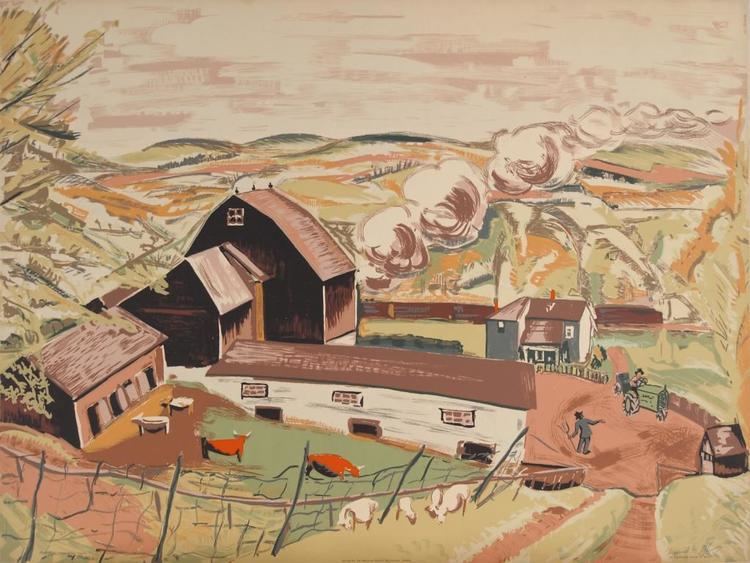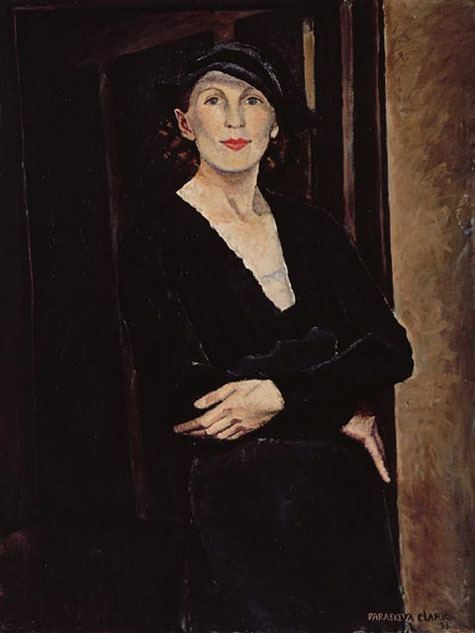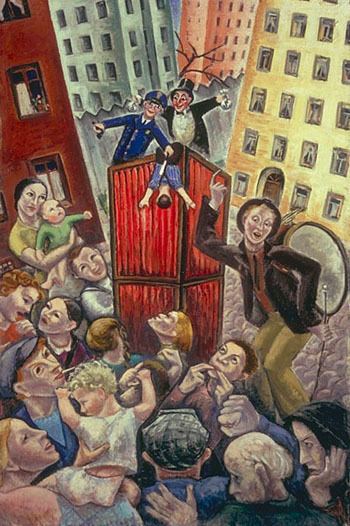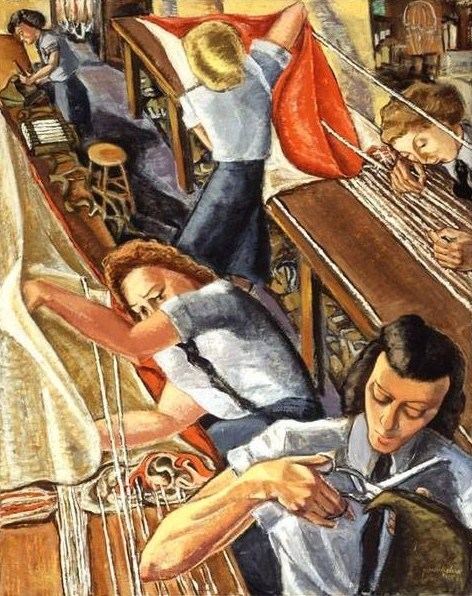Name Paraskeva Clark | ||
 | ||
Died August 10, 1986, Toronto, Canada Artwork Parachute Riggers, Self-portrait with Concert Program Spouse Philip Clark (m. 1931), Oreste Allegri Jr. (m. 1922–1923) Children Clive Clark, Benedict Allegri Parents Avdey Plistik, Olga Fedorevna People also search for Benedict Allegri, Avdey Plistik | ||
Paraskeva clark an introduction
Paraskeva Clark (October 28, 1898– August 10, 1986) was a Canadian painter born in St. Petersburg, Russia Her work is often political as she believed that “an artist must act as a witness to class struggle and other societal issues.” She has been a member of such groups as the Canadian Group of Painters, the Canadian Society of Painters in Water Colour, Canadian Society of Graphic Art, the Ontario Society of Artists, and the Royal Canadian Academy. Much of her art now resides at the National Gallery of Canada and the Art Gallery of Ontario.
Contents
- Paraskeva clark an introduction
- In Praise of Canadian Paintings in the 30s I Paraskeva Clark
- Early life
- Artistic Influences
- Petroushka
- Political Influences
- Later life
- References

In Praise of Canadian Paintings in the 30s: I. Paraskeva Clark
Early life

She was born Paraskeva Avdeyevna Plistik, the first daughter of Avdey Plistik and Olga Fedorevna. She was the eldest of the couple’s three children and was afforded four years more schooling than most girls of the time. Her extended education can be attributed to both her father who enjoyed the Russian classics and “instilled in his daughter a love of books and learning,” as well as her mother who would make artificial flowers to supplement the family’s income. After graduating school in 1914. Clark worked as a clerk in a shoe factory where her father had been previously employed before owning his own grocery store. Clark’s mother Olga Fedorevna died of pneumonia in when Clark was 17, a mere year after the younger had graduated.

Enjoying the theatre as a young woman, Clark was initially interested in acting but deterred by the financial expense of training. After encouragement from her coworker Elza Brahmin, Clark attended evening classes at the Petrograd Academy of Fine Arts from 1916 into 1918 when the school was closed for a “complete overhaul of the art-education system” after the October 1917 revolution, and was reopened as the Free Art Studios, at which point Clark was admitted to the school which no longer required tuition and afforded her a stipend. She left in 1921 and was recruited among other students to paint sets for theatres. It was in this work that she met Oreste Allegri Jr., an Italian scene painter whom she would marry in 1922. March of the following year they had a son, Benedict, and the new family made plans to emigrate to France. Unfortunately Oreste Jr. drowned in the summer of 1923 before their plans could be carried out, and Clark and Benedict left for Paris and the Allegri family home by themselves in the fall. Though the Allegri’s were well connected in the art world and Clark met many artists through them – including Pablo Picasso - now she had little opportunity for her own art, while caring for her son and doing domestic work for her in-laws. Despite this she created Memories of Leningrad in 1923: Mother and Child in 1924, and a self-portrait in 1925.

In 1929, 6 year old Benedict was sent to a boarding school during week days and Clark took a job outside of her in-laws home, in an interior design shop. Here, she met her second husband, the Canadian accountant Philip Clark. Philip was visiting Europe for three months at the time, and the two kept in touch until he visited her again in 1931, at which point they decided to marry – possibly hurried by Paraskeva’s desire to avoid the attentions of her brother-in-law – and did so in London on the 9th of June 1931. After the wedding, Paraskeva and Benedict travelled with Philip to their new home in Toronto where the family welcomed a new son, Clive, in June 1933.
Artistic Influences

In 1916, Clark went to the Petrograd Academy of Fine Arts to look at the art teachers’ ads posted and it was there she discovered that the landscape painter Savely Seidenberg’s studio was on the same streetcar as the shoe factory where she worked – she realized she could keep both her day job and take art night classes as well. Seidenberg taught figure drawing as well as still life and for months, Clark, as a beginning student, drew in charcoal from plaster heads, all the while feeling envious of the advanced students who worked from a model. In getting to know more advanced students, Clark rejoiced in immersing herself in conversations with her peers about art styles like impressionism, post impressionism, cubism and the artists who were central to those movements.
Vasily Shukhayev was a relatively unknown painter and set designer whose students practiced life drawing and painting. The fallout from the Revolution (which occurred while Paraskeva was studying at the Academy) brought about a great upheaval in all the arts. Paraskeva was familiar with the many prominent artists of the time, Vladimir Tatlin was among them, who believed that they were creating a revolutionary art — Cubism and Futurism — for the new regime.
Kuzma Petrov-Vodkin, was a humanist painter who integrated the European influences of Matisse and Cezanne, with his personal Russian experience. He was a thinker, an intellectual, and from him Clark gained some sense of depth of an intellectual, thoughtful life, even though she might not have been conscious of this aspect of her education at the time. Clark was excited by the study of colour and still life, to which Petrov-Vodkin brought his theories of space and could relate to this way of depicting a visual perspective that was not an artificial architectural construction. It was from Petrov-Vodkin that Clark learned the technique of spherical perspective in which figures and objects are distorted from their perpendicular axis to produce dynamic moment.
Clark never lost what she gained from art school and in years to come, she would draw on her teacher’s concept of tilting the usual verticals and horizontals, she employs this technique in her 1947 painting Essentials of Life. Clark became preoccupied with form as Petrov-Vodkin understood Cezanne. He passed on to her his knowledge of Cezanne’s techniques in utilizing the shifting axes in a picture.
In three self-portrait studies dates 1918, 1919, and 1921 and works that date to these years, Petrov-Vodkin began to use rectangular framing elements— doors, windows, mirrors — set at variance to the horizontal and vertical axes of the paper or canvas to structure his subjects. These framing elements, are often painted in the positions that he believed best suited the painting. They are not parallel but are splayed slightly at one end and convergent at the other, giving the effect of space that is altered — bent or swollen with the life of the subject. Much like Cezanne, Petrov-Vodkin believed that the integrity of the canvas was of the utmost importance. He prioritized the overall composition, rather than committing to the exact detail and proportions of these doors, windows and mirrors. This composition served two purposes. It gave the painting a structural quality while intensifying the psychological reality of the sitter.
Clark’s Self Portrait of 1933 is a statement of personal strength and perhaps even independence from her former teacher, for although she borrows from Petrov-Vodkin’s compositional methods, he discouraged his students from using black. She made the decision to use black in the painting, creating her own aesthetic and moving away from the style of her teacher. She loved black, and it seems almost like a gesture of defiance to build a self-portrait around it. Looking at the self-portrait, the painting is unified by the tilt of the figure and the slanted architectural elements and the use of this kind of architectural framing device reflects the influence of her teacher Petrov-Vodkin. Clark employs the techniques she learned from her teacher—and utilized framing elements like doors, to structure her paintings. This can be seen in her painting Self Portrait, 1933. This portrait reflects Clark’s growth as an artist and as she leans against a door, we sense her strength stabilizing the canvas. Clark, in this self-portrait is embracing her strong facial features and accentuates them by employing minimal colour, allowing the lines of her dress to speak of understated elegance, the slight smile—her confidence.
In Clark’s work, we can see two influences: Cezanne and to a lesser extent Picasso. Cezanne because Clark used colour to define form; Picasso, for the way she organized her portraits and still life. The tilt of the surfaces and the placement of the objects show she understood Picasso as she put him together with Petrov-Vodkin to turn out her own Paraskeva Clark still-life’s. Her painting Pink Cloud, 1937 in the National Gallery of Canada collection was cited as an example of her delicate sense of colour: “In her use of colour to define form and render visible the solid shapes beneath the surface of things she is indebted to Cezanne and to a lesser degree Picasso.” Cezanne’s influence is especially clear in her 1939 painting In the Woods. The painting’s Cezannesque treatment of the forest floor shows the artist’s awareness of European trends as well as her Russian training under Kuzma Petrov-Vodkin.
Clark’s paintings Self Portrait 1933 and Portrait of Philip 1933 are her first major works that deal with the composition of the artwork, in which the subject is integrated in time, space and architecture. In terms of configuration she takes inspiration from Cezanne – the balancing of form, his structured and measured employment of the paint on the canvas. In Portrait of Philip for example, the artist creates a complex but very balanced pattern of parallel and perpendicular lines within the stable square of the canvas, containing and supporting the cool, appraising, sartorial figure of her husband. Space is constructed in such a way that the spectator looks down into the picture, and down at the figure of Philip in the deep, perspectively distorted chair, yet meets the glance of the man eyes to eye.
Petroushka
In Petroushka, Clark creates a seemingly innocent scene of street entertainers "to express her outrage at the recently reported brutal killing" of five striking steelworkers by Chicago police in the summer of 1937. The painting was inspired by newspaper reports and she chose to adapt the story of Petrushka (the Peter puppet and symbol of suffering humanity within Russian tradition) to a North American context.
Clark felt passionately about the role and responsibility of the artist: "Those who give their lives, their knowledge and their time to social struggle have the right to expect great help from the artist. And I cannot imagine a more inspiring role than that which the artist is asked to play for the defence and advancement of civilization".
Political Influences
As a young woman, Clark faced financial challenges in her pursuit of the arts. Her parents were working class Russians and she lived through a revolution in her home country. These factors contributed to her belief that it is “the artist’s responsibility to paint work that referred to class struggle and other social issues” In this vein, she was unimpressed by the work of those such as the Group of Seven for its lack of reference “to the real world and social issues related to class.” She had more reverence for her peers who were dedicated to creating “socially conscious Canadian art,” such as Pegi Nicol Mcloed, art editor of the Canadian Forum from 1935-1936, who introduced Clark to the noted anti-fascist Dr. Norman Bethune in 1936. Bethune and Clark had a brief affair, but more notable than that is the influence the relationship had on the latter’s politics. A socialist, a self-identified “red Russian” communist, and one of the few artists producing political art in Canada at the time; Clark at this point became active in the Committee to Aid Spanish Democracy. The second World War left the artist concerned for her homeland, and she was quite active in support of Russia against the nazi threat. In 1942, she sold some pieces of her art to donate the proceeds to the Canadian Aid to Russia Fund. She was also appointed by the National Gallery of Canada to record the activities of the Women's Divisions of the Armed Forces during World War II. Her art from these times reflected her strong political attitude, Petroushka (1937) being the most widely recognised, though the political significance of the work is seen in other works, as in Pavlichenko and Her Comrades at the Toronto City Hall (1943), on which she affirmed her sympathies with the inscription naming the “heroic red army.” Clark felt passionately about the role and responsibility of the artist: "Those who give their lives, their knowledge and their time to social struggle have the right to expect great help from the artist. And I cannot imagine a more inspiring role than that which the artist is asked to play for the defence and advancement of civilization." Her work was to become one of the few politically influenced pieces to survive the era.
Later life
Paraskeva Clark’s eldest son Benedict was hospitalized and diagnosed with schizophrenia after a nervous episode in 1943, and she put her artistic career on hold temporarily; though even when she resumed painting a year later she struggled to balance the responsibilities of her family life with her artistic ambitions. From 1951 to 1956, Clark gave several large solo shows which were favourably received. Her son Clive was married in 1959 and gave her three grandchildren, which were “a source of great delight” for the artist. In a poor turn of events Benedict was again hospitalised because of his mental health 1957, and this impacted Clarks’s production of art in a predictable manner. In 1965, after multiple rejections of her work, Clark resigned from the Ontario Society of Artists. Then in 1974, mother and son shared a show together during which the National Gallery of Canada purchased her piece Myself (1933). Many exhibitions of her work and new projects featuring her art came about in these later years of her life, including a 1982 film by the National Film Board of Canada, Portrait of the Artist as an Old Lady. Speaking of her art in 1974, Clark said “I cannot complain, I have had a very good career, considering a great deal of my time has been spent on being a wife and a mother.” Philip Clark died in 1980, and after living for a time in a nursing home Paraskeva Clark suffered a stroke and passed away on August 10, 1986, at the age of 87.
